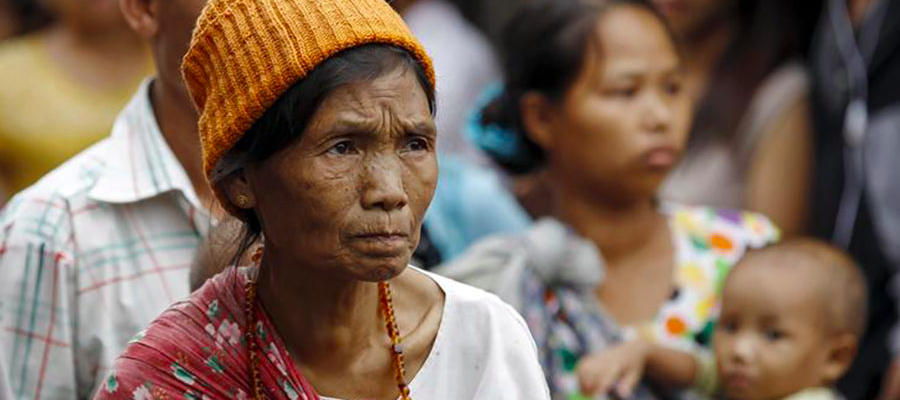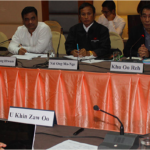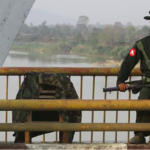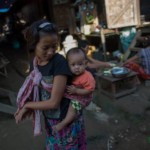By Stella Naw / The Irrawaddy | August 18, 2017
Two events indicating the prospect of peace and conflict were simultaneously taking place on Aug. 11, 2017.
One was a meeting between the Delegation for Political Negotiation (DPN), the negotiating body of the ethnic alliance the United Nationalities Federal Council (UNFC), and the government Peace Commission.
“The level of trust is now at zero,” said DPN leader Khu Oo Reh, reflecting the spirit of the meeting.
The other was indiscriminate shelling by Light Infantry Battalions 381 and 384, under the command of Military Operation Command 3, in an episode of conflict with the Kachin Independence Army (KIA) in Kasung village, Mogaung Township, Kachin State.
More than 1,000 people were displaced and several were reportedly killed due to the shelling. This follows the displacement of more than 1,000 people in June from Tanai in western Kachin State, after the Myanmar Army dropped leaflets in the area announcing clearance operations.
A Tatmadaw representative said in Parliament on August 14 that it is the military’s duty to enforce the “rule of law” in areas where the KIA is active and to bring local people into the fold of security provided by the military.
Active military hostility initiated by the Myanmar Army in Kasung must not be treated as “just another fight.” Sources in Kachin State suspect this move to be an initial step taken by the army to formalize an agreement made with China: to allow for the reported construction of a highway bypassing Kachin’s major cities, and merging into the route of the Ledo Road, which connected Kunming, in China’s Yunnan Province, to the Indian border town of Ledo during World War II.
The KIA’s Battalion 11, situated 3 miles north of Kasung, serves as a significant obstacle to the potential construction of such a motorway, which would pass through the village. The shelling could be interpreted as an attempt to clear the area in an early effort toward carrying out the plan to create such infrastructure.
The bombing of Kasung occurred around one month after Myanmar Army Commander-in-Chief Snr-Gen Min Aung Hlaing’s weeklong visit to India, where he had several top-level meetings with talks on both bilateral and military-to-military cooperation with his western neighbor.
Myanmar’s military has learned to thrive in its strategic position between Asia’s two giants, both seeking regional dominance. It was the British demarcation of borders that defined Myanmar’s boundaries as a state, and the lines set out by a colonial power have also contributed to the fate of generations of non-Bamar ethnic groups: squeezed between India, China, and the Tatmadaw troops are communities who have been stripped of their security and basic right to a life with dignity, particularly for those living along these borders.
Synonymous With the Military
For many communities in the ethnic states, the first Bamar people they encountered were Tatmadaw troops entering their villages, bringing with them human rights violations, looting and the destruction of property.
A 100-year-old displaced woman from Kasung said during an interview, “I crawled, I ran, I was carried on my son’s back across two rice fields, running away from ‘Myen’
Yet a translation of that interview then reads, “As the government troops were coming.” For many, the terms “Myen”—the term for “Bamar” in the Kachin Jinghpaw dialect—has become synonymous with Myanmar Army troops.
Similarly, in Karen language, “Pa Yaw” refers to both Bamar people and the Myanmar Army. A member of the Karen community recalls: “Back in the village where I grew up, people would say ‘Pa Yaw’ were coming when the Myanmar Army was entering the village.”
In Shan, the word “Marn” for the “Bamar” ethnicity is also used to describe Myanmar Army troops.
For people living in areas that receive little to no support or services from the central government, the only Bamar they have known are Myanmar Army troops. It has been their ethnic communities and respective ethnic armed organizations that have supplied basic infrastructure, health and education—not Naypyitaw or Yangon.
“The government is blocking the UN and other INGOs [international non-governmental organizations] from going to Kachin Independence Organization areas and quite clearly trying to destroy what has been built up. They are clearly determined to wipe out the infrastructure that has been built over the years,” said a longtime journalist and a regular visitor to Kachin State.
No National Identity
Since the founding of the Union of Burma in 1948, sufficient attention and effort have not been invested in creating a unified ideology to bring together the diverse range of ethnic communities within the country’s borders. No unified central ideology of nationhood was offered to the ethnic nationalities so that they might adopt the notion of a national identity.
As soon as the position of Commander-in-Chief was transferred from Smith Dun in February 1949 to Gen Ne Win, Burman officers filled the high commands, while non-Bamars were given new but lower ranks, described in “Burma in Revolt” by Bertil Lintner.
Fewer than 10 years after gaining independence, the political and economic prospects in Kachin State were falling drastically, and by 1951, “the Kachin State honeymoon was now over,” wrote Mandy Sadan in “Being and Becoming Kachin.” By the 1960s, less than 15 years after independence, more than a dozen ethnic nationalities had already armed themselves and saw such a struggle as the only way to call for political dialogue.
Despite the army’s central rhetoric to the national causes being non-disintegration of national solidarity and of the Union, the brutality committed by its troops has forced unprecedented numbers of civilians to flee, and it has inflicted prior and ongoing human rights violations upon vulnerable communities, most recently in the village of Kasung. Yet the Tatmadaw continues to advance as a major economic and political player and as a strategic partner of both China and India, often at the cost of the safety and security of Myanmar’s people.
Consecutive governments of a new independent Myanmar have failed to tackle the issue of creating a unified national identity since the colonial legacy. To avoid the fate of becoming another failed state, to which Myanmar is already on its way, the people need to look to each other to co-create a national identity. It must be envisioned not simply around the leadership of another individual, but based on shared values and mutual respect, and without coercion from any group to forfeit their unique identity.
Stella Naw is an advocate for equal rights and writes about peace and conflict in Myanmar.
This article originally appeared on The Irrawaddy on August 18, 2017.







